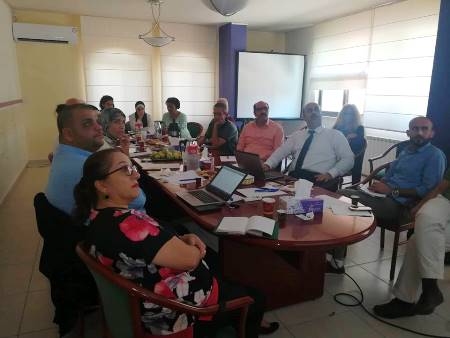|
Consultation session showcases results of study on government expenditures for the social sector
MIFTAH held a consultation session on September 22 with representatives from civil society institutions in which the results of a MIFTAH study were presented, showcasing government expenditures on the social sector in the past 10 years from the perspective of social justice. The objective of the session was to reevaluate the areas of government spending on the social sector through initiating a dialogue between civil society institutions, the various social sectors and ministries, especially those that provide direct services to citizens such as the ministries of health, education and social development. Outcomes and challenges The study concluded with a number of outcomes and challenges, indicating that in spite of the PA’s limited financial resources, the public budget has maintained its two parts: expenditures and revenues, the most controversial tool within decision-making circles given its development, social and economic dimensions. The outcomes also indicated to the still-wide gap between running and development expenditures over the 10 years between 2008 and 2018. It said the running expenditures constitute 86.6% of the general expenditure structure, which points to the continued trend of relief expenses in fiscal policies at the expense of development ones. Moreover, previous years have seen a retreat in the allocations of the security institutions in favor of allocations for the Education and Higher Education Ministry, which came second in the overall expenditure structure in the budget at 18.3%. This was followed by the Ministry of Health, at 9.7% in 2018, while the Ministry of Social Development was only 5% of the general budget, a percentage that does not reflect the scope of the duties and responsibilities of this ministry. Another challenge indicated in the report is that the ability of local revenues and those from the production and internal trade sectors to fund public expenditures has not exceeded 22.4% in the last five years. Furthermore, international financial aid and grants witnessed a setback in terms of their ability to fund public expenditures. After it had previously constituted 61%, it now has not exceeded 15.4% in the past 10 years. The continued employment crisis and the drop in capacitive energy in labor market also constituted another challenge to decision-makers whereby unemployment rates rose to 43.9% in the Gaza Strip and 18% in the West Bank, comprising an average of 27.7% in 2017. In both cases, this is considered high by global standards. The report highlighted the wide gap in poverty rates according to consumption patterns between the West Bank and Gaza Strip where the poverty rate in the Gaza Strip increased from 38.3% in 2009 to 53% in 2017. In the West Bank, however, this rate fell from 19.4% to 13.9% in the same period even though 72% of the overall aid provided by the Ministry of Social Development went to the Gaza Strip. It should be mentioned that over the last few years, MIFTAH has worked towards strengthening cooperation between the Ministries of Social Development, Health, Finance and Education and Higher Education, through supporting these ministries in issuing citizens’ budgets and building the capacities of their budget teams in addition to preparing guidebooks reflecting the procedures for producing annual budgets. The session is part of the Oxfam-funded project: “Finance for Development”, which is implemented by MIFTAH in partnership with AMAN, ARIJ and stems from MIFTAH’s growing interest in impacting fiscal policies from a social justice perspective. It also stems from the importance of the role played by public expenditure policies in decreasing the gaps between social components and in treating the impacts resulting from limited intervention on behalf of the most marginalized sectors, all of which threatens the values of democracy and social justice , which MIFTAH seeks to institutionalize.

http://www.miftah.org |